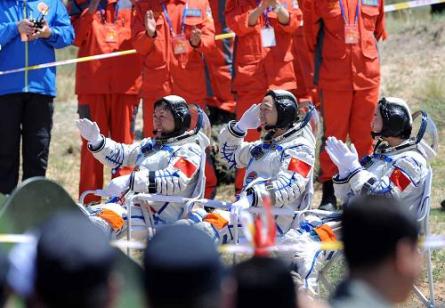The landing of the crewed Chinese Shenzhou-9 capsule after 13 days docked with space station Tiangong-1 marks a major checkpoint in the nation's space programme and serves as a strong advertisement for Chinese capabilities. The three taikonauts, as Chinese astronauts are known, appear safe and healthy after 13 days in space.
The Chinese flight comes on the heels of SpaceX's landmark flight to the International Space Station (ISS), which while uncrewed was the first commercial spacecraft to do so.
"As we noticed, the whole nation, overseas Chinese, our foreign friends as well as the media both at home and abroad have all paid close attention to the completion of the mission," says Wang Zhaoyao, director of the China Manned Spaceflight Office.
The spacecraft, a capsule, landed among the hills of the northern Chinese province of Inner Mongolia on 29 June. The flight marks only the fourth crewed launch in Chinese history, with a crew of three - the largest to date -- that included the first female taikonaut. China is only the third nation to launch people into space.
The landing was heavily publicized and covered by major media. Press organizations covered President Hu Jintao's visit to the Beijing ground control station, where he transmitted a personal message to the taikonauts. Immediately following reentry, the taikonauts were brought out to sit in lawn chairs and speak with reporters.
 |
|---|
©China Manned Spaceflight Agency |
The visibility is unusual, given that China's unmanned space and launch programmes are largely reserved for military use. The human spaceflight programme functions as a sort of advertising for China's technical capabilities - though Tiangong-1 is to be used for some scientific experiments, the practical utility of the station is limited.
China is in the midst of an ambitious space programme. Having launched its first taikonaut in only 2003, the nation has declared its intent to send both crewed and uncrewed missions beyond LEO. A new launch facility on Hainan Island, closer to the equator than the current Jiuquan facility, will be used to launch a larger version of the standard Long March.
The taikonauts manually docked several times with the Tiangong-1 space station, an uninhabited station in low Earth orbit (LEO). The mission was declared successful by the Chinese government. Though a major achievement in its own right, the mission is seen as a prelude to launching a larger, more capable space station, which China has announced it intends to do by 2020. The station may be permanently manned, as is the International Space Station (ISS) in which China does not participate.
"As we celebrate our success, we also realize that there is still a gap between China and the leading countries in the field of manned space technology," says Zhaoyao. "Much remains to be done for us to live up to the state's and our people's expectation."
China's achievements to date have been impressive, but they put the nation roughly on par with the United States or Soviet Union in the early 1960s. Though Tiangong-1 is permanently in orbit, it is not permanently inhabited and boasts nowhere near the same sophistication or flexibility as the ISS, nor will the planned follow-on station.
The nation's space programme is spurring a regional space competition. Though Japan has traditionally been the largest space power in the region, with heavy participation in the ISS programme and training for human spaceflight, neighboring nations such as South Korea and Indonesia are joining the fray. India, a major geopolitical rival, boasts a similarly ambitious but significantly less developed space programme.
While China's space programme has historically been largely derivative of existing Russian designs, the nation has become a major space power in its own right. In 2011, China's launch rate surpassed that of the US, though the nation lags in weight and sophistication of its satellites. The nation suffered several high-profile launch vehicle failures in 2011.
Source: Flight International


























